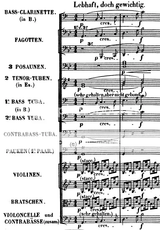Search Results
7/4/2025, 2:02:46 AM
>>126913771
>To me, 99% of the conductors/soloist play roughly the same
That's what you said. I gave examples of a few cases where that's not the case at all, including two where a composer specifically desired a specific effect that's often glazed over or skipped. Whether or not you find that to be an objective or subjective judgement is dependent on how much you value the art of interpretation and adherence to the letter. While you can certainly make out a good interpretation from a bad one without music education, you're always going to be missing part of the conversation.
Here's something I've brought up in this general a few times now, going back to Wagner. Pic related is the beginning of the Siegfried Act 3 Prelude. It starts piano, builds a crescendo, climaxes in a forte. Objectively speaking, we can say that there should, on the part of the orchestra and conductor, be an attempt to reflect Wagner's dynamic intentions during this piece. How pedantic you want to be is up subjective perhaps, but Wagner's intentions here are clear.
For example, Barenboim:
https://youtu.be/BLfTvcqwf1E?list=RDBLfTvcqwf1E&t=9
I wouldn't really say that this has the dynamics nailed. It sounds a little too dynamically flat for me; there's no true rise from piano to forte. Therefore I do not consider it an accurate portrayal of the artist's intentions.
Now compare it to Bohm:
https://www.youtube.com/watch?v=3Vbnv768gVE&list=RD3Vbnv768gVE&start_radio=1
This *is* dynamically correct. We get a true forte and the tactility of this Prelude comes together in a way that I consider superior to the previous recording. Whether or not you consider this important is up to subjectivity, but when reading the score it's pretty obvious what the composer objectively wanted. If music criticism seems too amorphous to you, then you're likely reading too many critics that refuse to elaborate their opinions with a basis in the score, and with a shallow view of the discography.
>To me, 99% of the conductors/soloist play roughly the same
That's what you said. I gave examples of a few cases where that's not the case at all, including two where a composer specifically desired a specific effect that's often glazed over or skipped. Whether or not you find that to be an objective or subjective judgement is dependent on how much you value the art of interpretation and adherence to the letter. While you can certainly make out a good interpretation from a bad one without music education, you're always going to be missing part of the conversation.
Here's something I've brought up in this general a few times now, going back to Wagner. Pic related is the beginning of the Siegfried Act 3 Prelude. It starts piano, builds a crescendo, climaxes in a forte. Objectively speaking, we can say that there should, on the part of the orchestra and conductor, be an attempt to reflect Wagner's dynamic intentions during this piece. How pedantic you want to be is up subjective perhaps, but Wagner's intentions here are clear.
For example, Barenboim:
https://youtu.be/BLfTvcqwf1E?list=RDBLfTvcqwf1E&t=9
I wouldn't really say that this has the dynamics nailed. It sounds a little too dynamically flat for me; there's no true rise from piano to forte. Therefore I do not consider it an accurate portrayal of the artist's intentions.
Now compare it to Bohm:
https://www.youtube.com/watch?v=3Vbnv768gVE&list=RD3Vbnv768gVE&start_radio=1
This *is* dynamically correct. We get a true forte and the tactility of this Prelude comes together in a way that I consider superior to the previous recording. Whether or not you consider this important is up to subjectivity, but when reading the score it's pretty obvious what the composer objectively wanted. If music criticism seems too amorphous to you, then you're likely reading too many critics that refuse to elaborate their opinions with a basis in the score, and with a shallow view of the discography.
Page 1
